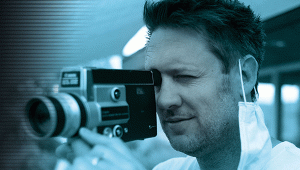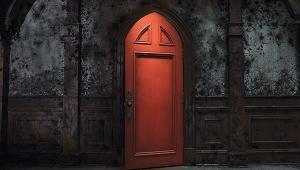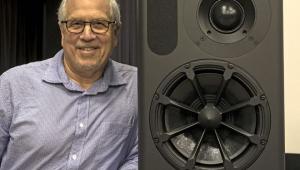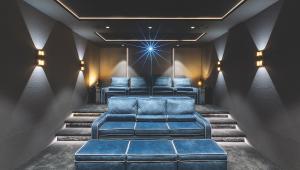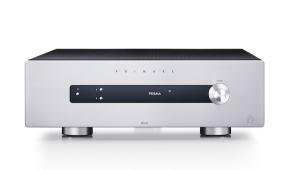Taking it to the IMAX: The past, present and future of the premium cinema corp
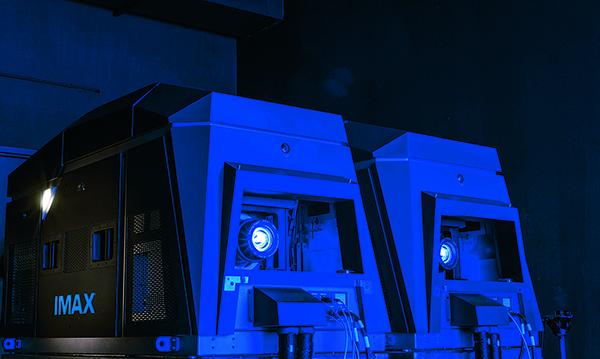
The slate of films featuring IMAX 'DNA' – either shot using IMAX cameras, formatted to suit, or given an IMAX-ready remaster – is growing, and in 2018, you can grab a seat at one of the company's 15/70-based theatres (such as the BFI IMAX), soak up its laser tech (at Cineworld Leicester Square or Cineworld Sheffield), or catch an IMAX Digital screening. But is the oldest and best-known premium cinema system damaging its brand through expansion into multiplexes, and is it up for the battle with object-based audio rivals? IMAX's Chief Technology Officer Brian Bonnick has the answers.
Obvious question: what's the difference between IMAX and a screen at my local multiplex?
You just gave me an hour’s worth of conversation! There are five areas that differentiate the IMAX experience. The obvious ones are the projection systems, which are proprietary and custom-designed, and the sound systems, and I could talk for hours on those.
Next is the venue itself. IMAX is very much about putting you into an experience. We need to immerse you, and one of the ways we do that is through the geometry of the theatre. Every IMAX theatre is what we refer to as a short-throw venue. In other words, the audience is sitting relatively close to the screen. When we convert, for example, a normal theatre into IMAX, we go in, remove their screen, put a new screen in, wall-to-wall, floor-to-ceiling, and we bring it a lot closer to the audience.
If you took somebody sitting in the front seat, and they were looking at the original screen in that theatre, we are bound by the constraints of the walls and the ceiling of that theatre. While their screen doesn’t usually go wall-to-wall, we can certainly do that, but that’s still not giving us a broad enough field of view. By bringing the screen forward, it’s the equivalent of putting in a new screen where their's was, that goes beyond the walls of their building.
Also, the theatre is acoustically treated to IMAX standards; specifications have to be adhered to. We want you to be able to go into any IMAX theatre, and have the same experience. And to do that, we need to make them all sound the same.
Another part we deal with is at the front end. IMAX is ‘cradle-to-grave,’ and the cradle part is our filmmakers. We’ve worked with filmmakers for 40 years. Many of the top ones – I’m sure you’re familiar with Chris Nolan, J. J. Abrams, Michael Bay, the Russell brothers... – they’ve all embraced IMAX. In combination with their skillsets, and the use of IMAX technologies such as our large-format cameras, they are able to capture content in a way that you normally can’t in any other venue. We’re able to support a 1.43:1 aspect ratio. If you compare that to the home, 1.85:1, 2.20:1, etc, it makes it much more immersive. Our filmmakers may choose to show the majority of their film with that larger aspect ratio, or they may choose to use it to reflect an emotion.
The other area that we have is our digital remastering technology. This is the method by which we can take content and completely remove the grain, and create a clean slate if we wish, or something in between. We’re able to remove artefacts in an image, and improve the sharpness and the overall quality, the desaturation. We’re able to take a piece of content that looks very grainy and clean it up. It’s a day-and-night type thing.
Is this what IMAX calls ‘DMR’?
That’s correct. We’re controlling the cameras at the front end with the filmmakers, we’re controlling the DMR process, again, with the filmmakers. And we have a sound system and projection system designed to work with these other elements. We’re controlling the whole eco-system. And as you know, in any home theatre system, it’s only as good as the weakest component. In our case, each component is designed knowing what’s upstream of it, and taking full advantage of it.
When we’re doing that workflow process, we’re not doing it out-of-sight of the filmmaker. They are heavily involved. We don’t want to degrade the quality of what they’re trying to convey. For example, with audio, you’ll see a lot of soundtracks coming out in other venues where they’re using multiple loudspeakers. You know, that’s fine. They’re just kind of cranking up the special effects, and that’s fine once in a while, but it wanes on you. We’re trying to provide an experience that’s lifelike to the viewer, and that means that you have to work with the filmmaker, because sometimes you’ll have someone who actually wants us to put more film grain in, and then you’ll find another who wants grain removed, or wants it not quite as sharp as we can make it. There’s not a right or a wrong. It’s a question of making sure that we’re bringing the right tools to the table.
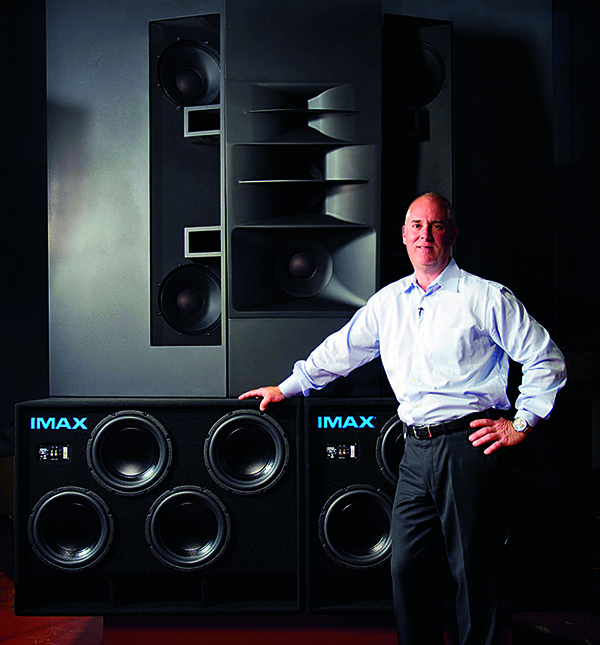
When a studio comes to you with a project and says they want to have some sequences in 1.43:1, jumping up from 2.39:1, they obviously make the decision during pre-production...
We have them coming to us well in advance saying they want to do a film, they want to do it in IMAX, and they want to do something different. As a result of Dunkirk, they’ve been approaching us and saying, ‘I love what Nolan did.' We climb into bed with them, and we start to figure out creatively what it is they want to do. Some have particular shots they want to do that way, some have entire scenes, some have a hell of a lot of the movie they want to do. They usually want to take advantage of the IMAX aspect ratio, they want to take advantage of the sharpness of the projectors, and the higher resolution.
Are there base criteria for screen size and number of seats in an IMAX cinema? There are IMAX screens in UK cinemas that are smaller than the BFI iteration...
There’s a bit of a misnomer that if the screen’s not big, it’s not IMAX. I acknowledge that when you walk into a theatre and the screen is eight stories tall, your body relative to the venue makes it feel bigger. But, visually, when the lights go off, and you’re watching that movie, it doesn’t matter whether the screen is 40ft wide or 80ft wide. It has the same field of view.
We work hard at trying to get into the largest auditorium within a multiplex. At some of those venues, if the design precludes us from going in, then we have to make do with what’s available. We work with the exhibitor to select sites that have good demographics to support it from a business level, but also try to optimise size, acoustics and all the geometric things that are of concern to us. You’re correct, in some cases it’s not an 80ft screen, because they just can’t support it. [But] we can put a screen in, and maintain that accentuated aspect ratio, so when the lights go off, you’re still getting that wall-to-wall, floor-to-ceiling experience.
The same optimised viewing angle too? Yes. There are venues we turn down all the time where we don’t believe we can achieve that. As an engineer, it’s less to me about the screen size, although we’re not going to go into a 30ft screen. There are more technical parameters that we know, from experience, that when you get less than a field of view of ‘x’, you’ve started to detract from what can be perceived as IMAX.
IMAX began with 15/70mm theatres. Will any more of these be built? Or is what we’ve got as many as we’ll get?
What we’ve got now is certainly as much as we’ll get. We’ve got some that have been mothballed and we’re seeing what we can do about bringing them back into the marketplace. To be blunt, we’re not quite sure right now, because we haven’t been through the assessment. But we won’t be manufacturing more, because [it's] a legacy design. It’s 40 years old. We can refurbish ones we’ve already got, but we couldn’t build from scratch. I just don’t think economically that anybody could do that.
IMAX laser has a 1.43:1 aspect ratio too. Is it a replacement of 15/70 in terms of screen resolution and performance?
I actually like the laser better. I still like the film, in that it provides a film look. When we designed our laser system, we did so with the mindset of trying to approximate the visual experience that you get with film, as opposed to a video look that you can get with a lot of other systems. There are subtleties in our laser system that, even down to some of the types of glass we’ve used in the optics, reflect what
a film-based system provides. Obviously, we don’t
get the artefacts and dust onscreen.
I think where films stand out is where they have been captured at 18,000 [horizontal] resolution.
Our film system is capable of displaying that where obviously our digital projectors are capable of 4K.
We use dual projectors, and we’re employing a technology that allows us to increase the perceived resolution because we’ve got double the number
of pixels. It’s not quite 8K, but when you look at the technology we’re employing, it’s a lot more than 4K. So, both have their advantages, and both can work side-by-side very well. Going forward, I think our GT laser, the one that does 1.43:1, is a lot more capable of filling that gap.
Does showing a regular 2K or 4K film in an IMAX screen damage the brand?
If they’re showing a film that is not issued by IMAX,
a standard goes up on screen to say that you are not watching an IMAX movie. There aren’t a lot of movies that get shown that way. We have a pretty heavy slate of films now. I think we’re putting out a movie roughly once every week and a half on average. Last year we did about 60 films.
Not every film gets processed the same way. They’re dependent on how the filmmaker and their team made it. Some are almost engineers themselves – they understand how to capture content technically, and they create a near-pristine piece of quality content right out of the box. Others do not. So, the way we apply our technologies is very specific to every film. We don’t have a cookie-cutter process. Every film IMAX looks at, in conjunction with the filmmaker, we determine ‘What does this film need?’, recognising number one that we’ve got a projection and sound system that exceeds anything else out there.
For example, just about every filmmaker, when their soundtrack comes through, can have it remastered. Our system can go an entire octave lower than anybody else’s. That octave gets you into that phase where, for example, in Dunkirk, when those fighter planes were shooting and flying, your body is almost palpitating. It’s the difference of being at a rock concert where you can feel your chest beating, versus hearing that rock concert with a nice sound system. It sounds nice, but it’s not the same. We can take the same content someone else has got and it’s going to look better on our system because we know how to manage convergence, brightness, and pixel alignment. These are all subtle, technical things, but when they start to go awry, the quality on the screen is not as good.

IMAX audio used to be a six-channel system, but it's developed since...
We have a 12-channel system now. It’s not to compete with other people who are offering 60 channels and so on. It really has merit in our largest venues. What we’ve done is we’ve added two additional speakers on the side walls, and four additional loudspeakers in the ceiling.
In a lot of these systems with multiple loudspeakers, there are a couple of issues. They do a very good job of giving a point source, or sound coming from multiple locations in the theatre. The drawback is that you can’t spend a ton of money on those loudspeakers, because you’ve got anywhere from 20 to 60 of them in there. So you tend to get poor-performing loudspeakers. Yes, you can put a sound from a certain point, but the sheer cadence and the quality of that sound, the realistic aspects of it, just aren’t going to be there.
The other problem is they make one soundtrack and they’re relying on a computer to remix it, based on the number of speakers in that theatre. So, if I have an object-oriented sound system that has 20 loudspeakers versus 60, the processor in the theatre has to figure out how to restructure that sound. It does a pretty good job, but it’s different. I think it’s a good system, and I think it’s an ideal system for a home-type environment. That’s, I think, why it’s there. But we’ve taken a different approach – which we were doing 40 years ago – in that we’ve got discrete channels, and a discrete subwoofer, which are all full-range. We’re able to provide you with an extreme, high dynamic range audio soundtrack, way beyond that of anybody else. We jokingly say that you can literally hear a pin drop in the theatre, and you can hear a rocket ship taking off at 118dB or 120dB without distortion.
Everyone’s talking about object-oriented sound and all these special effects. That’s fine for a special effects movie where the sounds are not real. You can’t do them wrong because there’s no reference to base them on. But when, for example, you’re showing a film like Dunkirk, our human brains know what a plane should sound like, we know what a bomb going off should sound like, and we have a perception of what the reality of that sound is. In order to reproduce that, every loudspeaker has got to be tuned the same as the next.
Everyone else is using tuning systems that will have, say, 31 bands of tuning, plus some parametric bands too, but that’s fundamentally it. In our system, we employ computer algorithms, and we use a physical tuner, so we don’t just rely on the computer. We rely on human ears, the old-fashioned way. But we take thousands and thousands of readings from all of these loudspeakers from 20 different spots within the theatre. The computer system stores all this information, and we can make adjustments any time we want.
And you go loud too...
These are loudspeakers that are designed for an IMAX short-throw venue, and where we want to provide you with the loudest sound when it happens. We generally don’t play it super-loud. Our amplifiers have well over 25,000W of power. At any point
in time, typically, our amplifiers are running at 100W-200W. The point is, I’ve got so much darned headroom on those amplifiers, that when that airplane starts shooting or that bomb blows up,
I don’t have any distortion to worry about.
And these are all factors that contribute to creating that feeling of realism of sound, and that’s important.
How often are your projection and sound systems calibrated?
It’s great when a tuner comes in and tunes your theatre today, and for the next two weeks it all looks great. But what happens down the road? Obviously, we can’t keep an engineer on site, so we have microphones located around the theatre, and every morning they listen to some specific sounds, and they compare them to a reference design, and they’re capable of making adjustments, should
there be a variation in sound.
Loudspeakers are like car tyres. They do vary, with temperature and humidity, so we’re able to ensure that the sound is tuned perfectly every single morning. Similarly, we use a camera that looks at the screen every single morning. I can’t tell you all of the things it does because it’s proprietary, but one of the things it checks is brightness. If we’re using a dual projector system, it makes sure that both projectors are putting out a) the proper light level and b) that they’re within a minute tolerance of each other. Because in 3D, in a dual configuration, if your light levels are off a little bit, your brain picks up on things, and funny things start to happen.
We’re now at a point where 94 per cent of all field issues are resolved remotely, where many years ago, you’d have to send people out. We do send techs out twice a year, and they do maintenance, like changing filters. They will do a validation. And if it’s something we can’t adjust remotely, they will go in at that point.
Your partner is Barco with its stacked projectors in your digital IMAX screens. Are you using Barco technologies for the IMAX Laser system?
No. Barco is absolutely a partner of ours, designing the light source that feeds our GT laser, and it designs it to our specification. Everything else in
the system I'm designing.
Every projector in the world has typically – if it’s not a colour wheel – three chips mounted onto a prism. Light bounces into that prism, goes through a red, green and blue filter to each of these three chips. The chips are all aligned on this prism, so if I turn pixel ‘number one’ on, they all direct pixel ‘one’ out of the lens, and they have to be superimposed on each other – that’s what the prism does. That works great.
The problem is that it was never designed to handle really and truly the power level that lasers put out. You have stray light... there is this piece of glass, and the chips all start to expand and contract. On your screen, you now get pixel misalignment; you get convergence issues where you might see a fine magenta or green line, depending on the leading or lagging edge. Stray light is bouncing around, grossly affecting contrast. Also, because you’ve got so much glass, it affects sharpness, so you’ve got three Achilles' Heel problems. With our laser, we spent over $60m developing a solution. We threw away the prism, we have these chips mounted about a foot apart from each other, so there’s no stray light, and our contrast levels more than double IMAX film. Even in our lenses, we’ve removed glass, and we get this unbelievably sharp image. And then our projectors are an ecological system; they have humidification and temperature management systems within the projector to maintain a constant level.
Now we have an environment where I have no stray light, chips mounted far apart, no glass, so my sharpness is better, and I’m maintaining a thermal equilibrium environment. I don’t have pixel drift and I don’t have convergence issues.
Does IMAX have a mission statement?
I can tell you what mine is! It fundamentally boils down to us being all about providing the world’s most immersive experience for consumers, that
lets them go somewhere that under normal circumstances they would never be able to go
and experience. I guess it’s a bit like calling it a VR experience, in a sense. Our intention is to remain
at the top of the food chain.
Lastly, how do you watch movies at home? Presumably you’re into home cinema as well...
Yes. But how do I watch them? Not as well as when in the theatre! I have a home-built projector, being an engineer, and a 16ft-wide screen, and I sit very close to it as if it was IMAX. I’m very much into the audio and the visual, and home automation, and all that stuff. I think it probably just goes with the territory.
 |
Home Cinema Choice #351 is on sale now, featuring: Samsung S95D flagship OLED TV; Ascendo loudspeakers; Pioneer VSA-LX805 AV receiver; UST projector roundup; 2024’s summer movies; Conan 4K; and more
|

